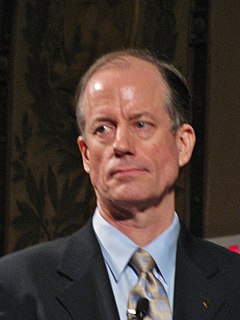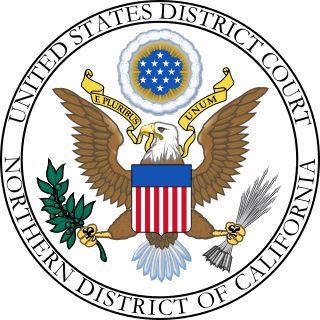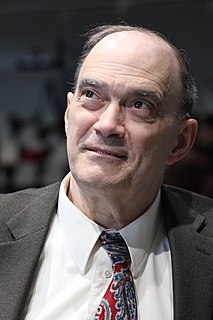
NSA warrantless surveillance — also commonly referred to as "warrantless-wiretapping" or "-wiretaps" — refers to the surveillance of persons within the United States, including U.S. citizens, during the collection of notionally foreign intelligence by the National Security Agency (NSA) as part of the Terrorist Surveillance Program. In late 2001, the NSA was authorized to monitor, without obtaining a FISA warrant, the phone calls, Internet activity, text messages and other communication involving any party believed by the NSA to be outside the U.S., even if the other end of the communication lay within the U.S.

Russell D. Tice is a former intelligence analyst for the United States Air Force, Office of Naval Intelligence, Defense Intelligence Agency (DIA), and National Security Agency (NSA).

The Terrorist Surveillance Program was an electronic surveillance program implemented by the National Security Agency (NSA) of the United States in the wake of the September 11, 2001 attacks. "The program, which enabled the United States to secretly track billions of phone calls made by millions of U.S. citizens over a period of decades, was a blueprint for the NSA surveillance that would come after it, with similarities too close to be coincidental". It was part of the President's Surveillance Program, which was in turn conducted under the overall umbrella of the War on Terrorism. The NSA, a signals intelligence agency, implemented the program to intercept al Qaeda communications overseas where at least one party is not a U.S. person. In 2005, The New York Times disclosed that technical glitches resulted in some of the intercepts including communications which were "purely domestic" in nature, igniting the NSA warrantless surveillance controversy. Later works, such as James Bamford's The Shadow Factory, described how the nature of the domestic surveillance was much, much more widespread than initially disclosed. In a 2011 New Yorker article, former NSA employee Bill Binney said that his colleagues told him that the NSA had begun storing billing and phone records from "everyone in the country."

Michael Vincent Hayden is a retired United States Air Force four-star general and former Director of the National Security Agency, Principal Deputy Director of National Intelligence, and Director of the Central Intelligence Agency. Hayden currently co-chairs the Bipartisan Policy Center's Electric Grid Cyber Security Initiative. In 2017, Hayden became a national security analyst for CNN.

ThinThread was an intelligence gathering project by the United States National Security Agency (NSA) conducted throughout the 1990s. The program involved wiretapping and sophisticated analysis of the resulting data. The program was discontinued three weeks before the September 11, 2001 attacks due to the changes in priorities and the consolidation of U.S. intelligence authority.

Mark Klein is a former AT&T technician and whistleblower who revealed details of the company's cooperation with the United States National Security Agency in installing network hardware at a site known as Room 641A to monitor, capture and process American telecommunications. The subsequent media coverage became a major story in May 2006. He wrote a book about the NSA and AT&T's cooperation in surveiling everyone on the internet and his experience in discovering it and trying to tell the public called Wiring Up The Big Brother Machine...And Fighting It.
Thomas Tamm is a public defender in Washington County, Maryland. He formerly worked as an attorney in the United States Department of Justice (USDOJ) Office of Intelligence Policy and Review during 2004 when senior Justice officials responded to the warrantless NSA surveillance concerning eavesdropping on U.S. citizens. He was an anonymous whistleblower to The New York Times, making the initial disclosures which led to reporters winning Pulitzer Prizes in 2006. Although Maryland agreed to drop ethics charges against him in 2009 relating to those disclosures, and the USDOJ announced it had dropped its investigation in 2011, the D.C. Office of Bar Counsel announced in January 2016 that it had brought disciplinary charges against Tamm relating to those events. Despite some controversy with respect to politicisation of that office and similar charges being brought to silence attorney whistleblowers especially beginning in 2014, Tamm in March 2016 agreed to public censure by the District of Columbia Court of Appeals in order to allow him to proceed with his life and career.

"Stellar Wind" was the code name of a warrantless surveillance program begun under the George W. Bush administration's President's Surveillance Program (PSP). The National Security Agency (NSA) program was approved by President Bush shortly after the September 11, 2001 attacks and was revealed by Thomas Tamm to The New York Times in 2004. Stellar Wind was a prelude to new legal structures that allowed President Bush and President Barack Obama to reproduce each of those programs and expand their reach.

Trailblazer was a United States National Security Agency (NSA) program intended to develop a capability to analyze data carried on communications networks like the Internet. It was intended to track entities using communication methods such as cell phones and e-mail.

Thomas Andrews Drake is a former senior executive of the U.S. National Security Agency (NSA), a decorated United States Air Force and United States Navy veteran, and a whistleblower. In 2010, the government alleged that Drake mishandled documents, one of the few such Espionage Act cases in U.S. history. Drake's defenders claim that he was instead being persecuted for challenging the Trailblazer Project. He is the 2011 recipient of the Ridenhour Prize for Truth-Telling and co-recipient of the Sam Adams Associates for Integrity in Intelligence (SAAII) award.

The Utah Data Center (UDC), also known as the Intelligence Community Comprehensive National Cybersecurity Initiative Data Center, is a data storage facility for the United States Intelligence Community that is designed to store data estimated to be on the order of exabytes or larger. Its purpose is to support the Comprehensive National Cybersecurity Initiative (CNCI), though its precise mission is classified. The National Security Agency (NSA) leads operations at the facility as the executive agent for the Director of National Intelligence. It is located at Camp Williams near Bluffdale, Utah, between Utah Lake and Great Salt Lake and was completed in May 2014 at a cost of $1.5 billion.

Turbulence is a United States National Security Agency (NSA) information-technology project started c. 2005. It was developed in small, inexpensive "test" pieces rather than one grand plan like its failed predecessor, the Trailblazer Project. It also includes offensive cyberwarfare capabilities, like injecting malware into remote computers. The U.S. Congress criticized the project in 2007 for having similar bureaucratic problems as the Trailblazer Project.

Jewel v. National Security Agency is a United States class action lawsuit filed by the Electronic Frontier Foundation (EFF) against the National Security Agency (NSA) and several high-ranking officials in the administration of 43rd U.S. president George W. Bush, charging an "illegal and unconstitutional program of dragnet communications surveillance".

William Edward Binney is a former intelligence official with the United States National Security Agency (NSA) and whistleblower. He retired on October 31, 2001, after more than 30 years with the agency.

Perry Fellwock is a former National Security Agency (NSA) analyst and whistleblower who revealed the existence of the NSA and its worldwide covert surveillance network in an interview, using the pseudonym Winslow Peck, with Ramparts in 1971. At the time that Fellwock blew the whistle on ECHELON, the NSA was a nearly unknown organization and among the most secretive of the US intelligence agencies. Fellwock revealed that it had a significantly larger budget than the Central Intelligence Agency (CIA). Fellwock was motivated by Daniel Ellsberg's release of the Pentagon Papers. Today, Fellwock has been acknowledged as the first NSA whistleblower.

Global surveillance refers to the practice of globalized mass surveillance on entire populations across national borders. Although its existence was first revealed in the 1970s and led legislators to attempt to curb domestic spying by the National Security Agency (NSA), it did not receive sustained public attention until the existence of ECHELON was revealed in the 1980s and confirmed in the 1990s. In 2013 it gained substantial worldwide media attention due to the global surveillance disclosure by Edward Snowden.
The Fourth Amendment Protection Acts, are a collection of state legislation aimed at withdrawing state support for bulk data (metadata) collection and ban the use of warrant-less data in state courts. They are proposed nullification laws that, if enacted as law, would prohibit the state governments from co-operating with the National Security Agency, whose mass surveillance efforts are seen as unconstitutional by the proposals' proponents. Specific examples include the Kansas Fourth Amendment Preservation and Protection Act and the Arizona Fourth Amendment Protection Act. The original proposals were made in 2013 and 2014 by legislators in the American states of Utah, Washington, Arizona, Kansas, Missouri, Oklahoma and California. Some of the bills would require a warrant before information could be released, whereas others would forbid state universities from doing NSA research or hosting NSA recruiters, or prevent the provision of services such as water to NSA facilities. The bills are based on a model act provided by the Tenther movement and Offnow.

Global surveillance whistleblowers are whistleblowers who provided public knowledge of global surveillance.
John Crane is a former Assistant Inspector General of the U.S. Department of Defense known for his advocacy on behalf of government whistleblowers. He was fired in 2013 and now works for the Government Accountability Project, a non-governmental whistleblower support organization.

A Good American is a 2015 Austrian documentary film that chronicles the work of whistleblower William Binney, a former official of the National Security Agency who resigned shortly after the September 11 attacks.














